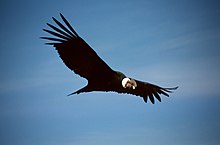Condor
| Condor Temporal range: 2.6–0 Ma Late Pliocene – Holocene |
|
|---|---|
 |
|
| Andean condor soars over southern Peru's Colca Canyon | |
| Scientific classification | |
| Kingdom: | Animalia |
| Phylum: | Chordata |
| Class: | Aves |
| Order: | Cathartiformes |
| Family: | Cathartidae |
| Genera | |
Condor is the common name for two species of New World vultures, each in a monotypic genus. The name derives from the Quechua kuntur. They are the largest flying land birds in the Western Hemisphere.
They are:
Condors are part of the family Cathartidae, whereas the 15 species of Old World vultures are in the family Accipitridae, that also includes hawks, eagles, and kites. The New World and Old World vultures evolved from different ancestors. However, they both are carrion-eaters and have distinctive bare heads.
Both condors are very large broad-winged soaring birds, the Andean condor being 5 cm shorter (beak to tail) on average than the northern species, but larger in wingspan. California condors are the largest flying land birds in North America. The Andean condor is second only to the wandering albatross (up to 3.5 m) in terms of wingspan among all living flying birds.
The adult plumage is uniformly black, with the exception of a frill of white feathers nearly surrounding the base of the neck which are meticulously kept clean by the bird. As an adaptation for hygiene, the condor's head and neck have few feathers, which exposes the skin to the sterilizing effects of dehydration and solar ultraviolet light at high altitudes. The head is much flattened above. In the male it is crowned with a caruncle or comb, while the skin of the neck in the male lies in folds, forming a wattle. The skin of the head and neck is capable of flushing noticeably in response to emotional state, which serves to communicate between individuals.
The middle toe is greatly elongated, and the hinder one but slightly developed, while the talons of all the toes are comparatively straight and blunt. The feet are thus more adapted to walking as in their relatives the storks, and of little use as weapons or organs of prehension as in birds of prey and Old World vultures. The female, contrary to the usual rule among birds of prey, is smaller than the male.
...
Wikipedia
